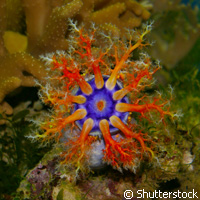Marine worms reveal close links to humans
They may not look alike, but according to an international team of scientists, two simple marine worms - Xenoturbellida and the acoelomorph worms - may be more closely related to complex organisms like humans and sea urchins than was previously assumed. Presented in the journal Nature, this discovery suggests a major revision to the phylogenetic history of animals is needed since it shows that these organisms did not always have as simple a structure as they do today. The animal kingdom is divided into different evolutionary lines. These include, among others, the protostomes or 'mouth first' and the deuterostomes or 'second mouth'. In the protostomes, the mouth that develops at the start of embryonic development becomes the organism's actual mouth, whereas in the deuterostomes, it becomes the anus and the mouth develops at a later stage. Until now, only three deuterostome phyla had been identified, namely: Chordates (e.g. vertebrates); Echinoderms (e.g. sea urchins, starfish and sea cucumbers); and Hemichordates (e.g. acorn worm). 'Our research shows that Xenoturbellida and Acoelomorpha together form the fourth phylum which we have called Xenacoelomorpha,' explains Dr Albert Poustka from the Max Planck Institute for Molecular Genetics in Berlin, Germany. The genus Xenoturbella lives off the coast of Iceland, Scandinavia and Scotland. It shares a simple body structure with the acoelomorph worms, which reach a maximum size of just a few millimetres and have no through gut, no gill slits and no body cavity. Many members of both groups live on the ocean floor and feed on organic particles in the sediment. Some species live parasitically, for instance in the intestines of sea cucumbers. According to the scientists, Xenoturbellida and Acoelomorpha have a shared ancestor, from which the complex group of deuterostomes descend. 'Therefore, contrary to what was previously assumed xenacoelomorph worms did not always have a simple structure but lost the characteristics typical for many deuterostomes over the course of evolution,' Dr Poustka says. 'The worms simplified their construction plan in reality because that was clearly as advantageous - or even more advantageous - than a complicated body structure.' With the help of processor-intensive mathematical models, the scientists examined new 'mini' genes - so-called microRNAs (ribonucleic acid molecules), - and amino acids from the fully sequenced mitochondrial genomes of Acoelomorpha and Xenoturbellida, and a large set of several hundred genes. The analysis of the Xenoturbella microRNAs and the acoelomate worm Hofstenia miamia showed that the previously analysed acoelomate worm Symsagittifera roscoffensis had lost many of these 'mini' genes. The gene repertoire of the animals in question pointed instead to the kinship between these animals and the deuterostomes. For example, they have a microRNA that was previously only known to exist in echinoderms and acorn worms. All of the animals analysed up to now from the new Xenacoelomorpha phylum have the gene RSB66, which could previously only be demonstrated in deuterostomes. The complex organisms of the protostomes and deuterostomes do not, therefore, originate both from acoelomorph as was previously assumed. Earlier studies were clearly subject to a systematic error that scientists refer to as the 'long branch artefact,' the researchers say. According to them, this error often arises during the comparison of the genotypes of organisms that have long developed independently of each other. Even if the DNA (deoxyribonucleic acid) sequences of some organisms mutated more quickly than the average, this effect can materialise. 'This was precisely the case with the acoelomorph worms,' Dr Poustka says. The researchers are now decoding the entire genome of the different species of Xenacoelomorpha in order to reach a better understanding of the evolution of the deuterostomes.For more information, please visit: Max Planck Institute for Molecular Genetics:http://www.molgen.mpg.de/Nature:http://www.nature.com/
Countries
Germany



